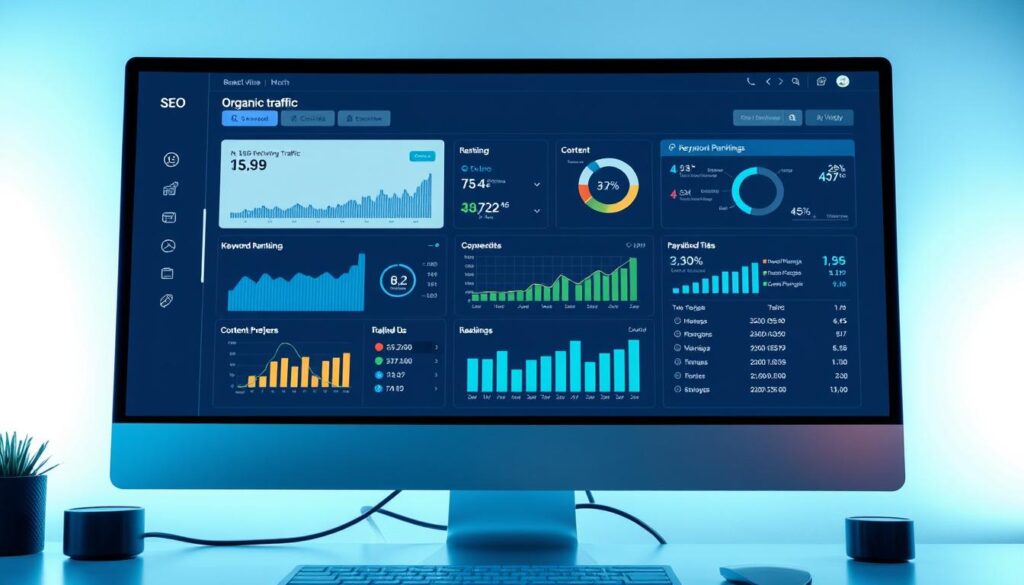When building an online presence, many wonder whether organic search growth requires upfront payments or just patience. Let’s clear the air: while clicks from search engines don’t come with a price tag, achieving visibility demands strategic effort. Think of it like planting a garden—you might not pay for sunlight, but tools, seeds, and care are essential.
Unlike paid ads that deliver instant traffic, improving your website’s ranking relies on long-term investments. Keyword research, content creation, and technical tweaks form the backbone of this process. For example, Backlinko’s success took years of refining strategies to dominate competitive searches. This slow-but-steady approach builds authority that lasts.
Balancing free and paid tactics is key. Paid search ads can boost short-term goals, but they stop working once the budget runs out. Organic efforts, however, compound over time. Tools like Ahrefs or SEMrush help streamline tasks, but subscriptions add up. The real cost? It’s a mix of expertise, time, and resources—not just dollars.
Key Takeaways
- Organic search traffic isn’t free—it requires time, content, and technical investments.
- Paid ads offer quick results but lack long-term sustainability compared to SEO.
- Keyword research and on-page optimization are foundational for visibility.
- Tool subscriptions and expert help often contribute to hidden costs.
- Successful strategies blend patience with measurable, incremental progress.
Understanding the Fundamentals of SEO and SEM
Search engines prioritize content that solves problems quickly. To rank well, websites must align with their complex algorithms. This requires balancing two approaches: one focused on gradual growth, the other on instant visibility.
Defining Core Strategies
Organic optimization involves improving site structure, keywords, and content quality. These efforts help pages rank without direct payments. For example, Moz’s guide to title tags shows how small tweaks boost click-through rates by 37%.
How Search Campaigns Differ
Paid ads deliver traffic within hours but vanish when funding stops. Platforms like Google Ads let businesses bid for top spots using specific phrases. Meanwhile, organic growth relies on:
- Technical improvements (site speed, mobile-friendliness)
- Relevant content matching user intent
- Authoritative backlinks from trusted sources
| Factor | Organic Approach | Paid Approach |
|---|---|---|
| Focus | Long-term authority | Immediate conversions |
| Cost | Time & expertise | Daily budgets |
| Results Timeline | 3-12 months | 24-48 hours |
| Sustainability | Grows over time | Stops with payments |
Tools like Ahrefs simplify keyword research for both methods. However, success in unpaid strategies demands consistent content updates and patience. A travel blog might gain 10,000 monthly visitors through articles alone—but only after six months of regular publishing.
The Hidden Costs Behind SEO Investment
Many businesses dive into search visibility efforts expecting quick wins, only to discover hidden expenses lurking beneath the surface. While results might appear organic, achieving them often requires surprising investments of both time and money.
Monetary and Time Commitments in SEO
Link building illustrates this perfectly. Securing quality backlinks demands hours of outreach, relationship-building, and content swaps. One marketing agency reported spending 15 hours weekly just to earn three authoritative links—time that could otherwise fuel product development.
Content creation also carries stealthy price tags. A single 2,000-word guide might require:
- $300-$800 for professional writing
- $150+ for custom graphics
- 5+ hours for keyword research
Technical improvements add another layer. Site speed optimization often involves developer fees, while mobile responsiveness updates can cost $1,000+ for complex platforms. These aren’t one-time fixes either—search engines regularly update ranking factors, demanding ongoing adjustments.
| Activity | Time Investment | Monetary Cost |
|---|---|---|
| Link Building | 10-20 hrs/week | $500-$2k/month |
| Content Creation | 8-15 hrs/article | $200-$1k/post |
| Technical Improvements | 5-10 hrs/month | $100-$300/hr |
| Tool Subscriptions | 2-5 hrs/month | $100-$500/month |
Analytics platforms like Ahrefs or Screaming Frog reveal critical insights but cost $100-$500 monthly. Combined with specialist fees, these expenses often exceed initial budgets. While traffic gains compound, the runway to results remains costly—a reality every business must factor into growth plans.
seo is free or paid: Weighing Free SEO Strategies Against Paid Approaches
Businesses often face a crossroads: invest time in gradual growth or spend money for instant visibility. Both paths have trade-offs—one demands patience, the other requires consistent budgets.

Exploring Free SEO Tactics
On-page optimization and earning backlinks are pillars of unpaid strategies. A local bakery, for instance, might climb search rankings by publishing weekly recipe blogs and partnering with food bloggers for guest posts. However, these efforts take 6-12 months to show meaningful results.
Hidden costs lurk behind “free” methods:
- 20+ hours monthly for content creation
- $100-$300/month for keyword research tools
- Ongoing technical updates to maintain site health
Benefits and Drawbacks of Paid Search
Google Ads can place a new e-commerce store atop search pages overnight. One outdoor gear seller doubled sales using targeted phrases like “hiking backpacks under $100.” But traffic vanishes if budgets dip—a stark contrast to evergreen blog posts.
| Factor | Free Tactics | Paid Ads |
|---|---|---|
| Time to Results | 6+ months | 24 hours |
| Monthly Cost | $50-$500 (tools) | $500-$5,000+ |
| Traffic Longevity | Years | Days |
As one marketer noted: “Paid search is renting traffic. Organic growth is buying real estate.” Balancing both approaches often yields the strongest outcomes—if resources allow.
Leveraging Keyword Research and Content Optimization
The foundation of any successful online strategy lies in understanding what your audience searches for and how to deliver it. Matching user intent with tailored content transforms casual visitors into loyal readers—or customers.
Mining Hidden Gems in Search Data
Advanced tools like Ahrefs and SEMrush reveal phrases people actually type into search bars. For instance, a bakery might discover “gluten-free birthday cakes near me” attracts higher conversions than generic terms. Long-tail keywords often convert better because they reflect specific needs.
| Tool | Best For | Avg. Monthly Cost |
|---|---|---|
| Google Keyword Planner | Basic phrase discovery | Free |
| SEMrush | Competitor analysis | $120+ |
| Ahrefs | Backlink tracking | $99+ |
Building Content That Converts
Great pages answer questions before readers ask them. A camping gear site might create guides like “How to Choose a Tent for Rainy Climates,” using terms from research tools. One outdoor brand saw a 40% traffic jump after optimizing headers and meta descriptions.
Placement matters: Keywords in titles and first paragraphs signal relevance to search engines. But stuffing ruins readability. As one marketer noted: “Tools show us the path, but content builds the journey.”
Balancing optimization with natural writing keeps people engaged. Regular updates ensure pages stay relevant—a recipe blog refreshing old posts gained 25% more organic traffic in three months. Quality content paired with smart keyword use creates lasting value.
Maximizing SEO Tools for Enhanced Online Visibility
Unlocking your website’s full potential requires the right digital toolkit. Specialized platforms turn complex data into clear action plans, helping you fix weaknesses and outpace rivals.

Technical SEO Tools and Analytics Insights
Google Search Console remains essential for spotting crawl errors. Screaming Frog crawls up to 500 pages for free, revealing broken links or duplicate content. One outdoor gear brand fixed 32 broken links identified through these tools, boosting their rankings by 18%.
Ahrefs excels in backlink analysis. Its Site Explorer feature shows which pages attract the most traffic. For example, a cooking blog discovered 43% of their traffic came from 12 underperforming posts—prompting targeted updates.
| Tool | Best Feature | Cost |
|---|---|---|
| Google Search Console | Index coverage reports | Free |
| Screaming Frog | Site structure analysis | Free/$260/year |
| Ahrefs | Backlink quality scoring | $99+/month |
Tracking Performance and Competitor Metrics
SEMrush’s Position Tracking tool monitors daily ranking changes. When a travel site noticed sudden drops for “best hiking boots,” they found competitors had updated content with video guides—prompting their own multimedia strategy.
Key tracking practices:
- Compare your keyword volume share vs. top rivals weekly
- Analyze competitor site speed using GTmetrix
- Set up custom alerts for brand mentions across search engines
Continuous monitoring helps adapt quickly. A tech startup adjusted their content calendar after seeing rivals gain traction with “AI productivity tools” searches—resulting in 22% more organic visits in 8 weeks.
Integrating SEO and SEM for a Comprehensive Digital Strategy
Balancing two strategies ensures businesses don’t put all their eggs in one basket. Pairing gradual organic growth with instant paid campaigns creates a resilient marketing plan. This hybrid model fills gaps when one method underperforms while amplifying overall reach.
Choosing the Right Mix for Your Business
Start by analyzing high-value terms. Competitive phrases like “luxury watches” might need paid ads to break through, while niche terms like “vintage watch repair” can thrive organically. Tools like SEMrush highlight where rivals invest, helping allocate budgets wisely.
Technical SEO foundations ensure websites earn lasting traffic. Fixing crawl errors or improving mobile speed makes paid efforts more effective. One furniture retailer combined blog posts targeting “mid-century decor ideas” with Google Ads for “sofa sale”—resulting in 68% more conversions.
| Factor | Integrated Approach | Standalone Tactics |
|---|---|---|
| Search Results Coverage | Top 3 spots + organic listings | Limited visibility |
| Cost Efficiency | Reduces CPC through better Quality Scores | Higher spend for same impact |
| Data Sharing | PPC data informs organic keyword strategy | Isolated insights |
Follow these steps to build your strategy:
- Audit current search performance for websites
- Allocate 30% of budget to high-intent paid SEO terms
- Use heatmaps to refine landing pages—a key part of conversions
“Paid campaigns buy you time while organic efforts mature. Together, they’re unstoppable.”
Monthly check-ups keep strategies sharp. Track which search results pages blend both methods successfully, then double down. Remember: flexibility beats rigid plans in fast-moving markets.
Conclusion
Digital marketing success isn’t a choice between time and money—it’s about synergy. Organic search builds lasting authority, while paid campaigns address immediate needs. For example, improving on-page SEO foundations like title tags can boost visibility, but maintaining momentum requires monthly investments in content and tools.
Consider hidden costs: crafting quality content demands hours each month, and search engine algorithm updates may require technical tweaks. Paid ads deliver quick clicks but drain budgets rapidly—$500 monthly might vanish in days without conversions.
Balance is key. Allocate 60% of resources to organic search efforts and 40% to targeted ads. Small businesses might start with DIY keyword research, while enterprises invest in premium tools. Track progress quarterly to adjust spending.
Ready to start? Explore free trials of platforms like Google Keyword Planner. Pair these with strategic ad spending for a balanced approach that grows with your business.
